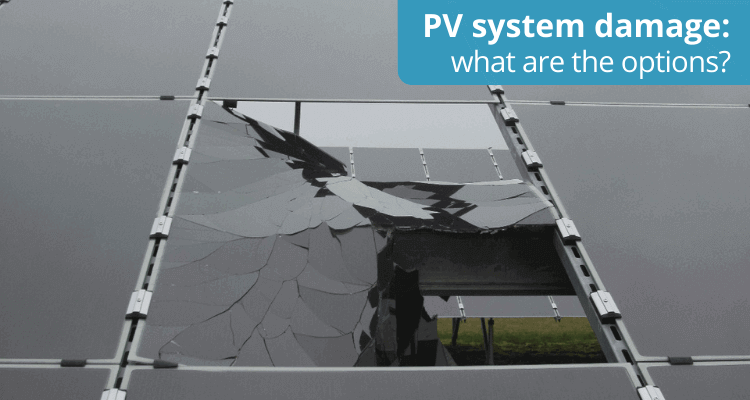Photovoltaic system damage: what are the options?
How and in which case can a photovoltaic system be repaired? What options do you have if the system has to be dismantled? Find out what is important for repair, recovery, and recycling.
If a photovoltaic system is running poorly, i.e. the yields fall short of expectations, the first thing you should do is check your systems’ monitoring. There, some causes can already be identified and partially remedied by software solutions.
In the second step, if remote diagnosis is not sufficient, the system must be examined by a specialist. On site it can be determined whether the fault originates from modules, inverters, or electrical connections.
If components such as modules, inverters, the energy management or the data logger are defective, you should check if you are still entitled to warranty service (see warranty rights and guarantees). If you are insured accordingly, you should report the damage to the insurance company (see Everything You Need To Know About Photovoltaic Insurance).
“Refitting”: how to repair
The replacement of defective modules or inverters implies major modifications. Old inverters can often be replaced by modern devices. This is more difficult with defective solar modules, as sizes and designs have changed considerably in recent years.
Replacement may be available on the secondary market, where older and repaired modules can be obtained.
Example: repair after a hailstorm
Imagine that hail has destroyed some modules of your PV system.
Option 1: defective solar modules will be replaced in the same quantity by currently available products with higher output. Advantages are cost-effective procurement and installation, as long as the new format does not deviate too much from the old one. However, the overall appearance may differ visually. The resulting additional output is only remunerated at current conditions and must be reported as a separate installation.
Option 2: defective solar modules are replaced by current products with higher individual output but the same overall output. In this case, the different formats and outputs are combined in respectively completed strings. The new modules can be procured easily and cost-effectively. The overall picture can be impaired, and the installation costs can increase.
Option 3: defective solar modules are replaced by suitable replacement modules with the same or similar output. The overall picture and the overall performance hardly change. The installation costs are low. However, module procurement is more difficult, and the module price is usually significantly higher.
Option 4: you replace the entire photovoltaic system (see Repowering Solar Power Plants).
Only defective solar modules may be replaced
The Renewable Energy Sources Act (EEG) stipulates that only defective modules may be replaced, otherwise the entitlement to remuneration may expire. The EEG Clearing House has defined what a defect is. The defect must be proven to the network operator (EVU). What is accepted as proof must be clarified with the grid operator.
Dismantling of entire plants
It is a good idea to think about the end of a solar power plant as early as its installation, and to build up reserves for dismantling and recycling. If nothing else has been agreed with the property or roof owner, you might have to bear these costs .
In the case of leased roofs or areas, the contract usually specifies how the site is to be left behind after the end of operations. Dismantling should be carried out by specialist companies so as not to leave any damage to roofs or electrical installations.
Recycling dismantled modules
Modules that are still functional may not be disposed of or recycled in accordance with the Electrical and Electronic Equipment Act. You may, however, sell them under certain circumstances. Repair is possible in case of the following visible damages:
- slight edge chipping on double glass modules
- slight deformations or dents and drill holes in the module frame
- scratches in the back foil, which do not reach the cells
- defective bypass diodes
- defective connectors, cables, or junction boxes in general
- detached or torn back foils
There are also modules with invisible damage, such as light-induced degradation (LID), potential-induced degradation (PID), slight hotspots or weakly developed micro cracks; these modules can still be used. Such damages are evaluated by experts.
Depending on the module type, repaired modules may still be valuable. Especially if they are used as replacements in old systems. Old modules are less suitable for new projects, as they are not financed by banks due to the lack of guarantees.
Dispose of defective solar modules
Irreparable modules must be recycled. This is the case:
- if the glass breaks, which makes the whole module unstable.
- if module frames are strongly deformed
- if hotspots or burn marks are visible
- if module junction boxes have fallen off or been torn off
- if edge areas are delaminated and there is a risk of short circuit
Private plant owners may hand in their discarded photovoltaic modules free of charge “in quantities customary in households” at local recycling yards. These probably accept several dozens of modules without any problem, but not whole truckloads.
Commercial, larger quantities of modules must always be collected by manufacturers or distributors at their own expense if the date of placing on the market is after the cut-off date in October 2015.
In case of older products or products from manufacturers who are insolvent, the costs remain with you. This can be very costly for large module quantities. A major cost factor in the recycling process is transport.
Specialized service providers who have framework agreements with logistics companies may be able to offer you cost advantages over smaller companies.
This article is a free translation from the article created with the kind support of Martin Schachinger, Managing Director, pvXchange Trading GmbH.
To read the original version (in German): Photovoltaikanlage defekt: Welche Optionen gibt es?.





